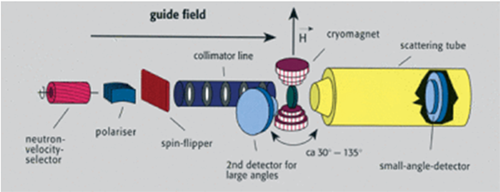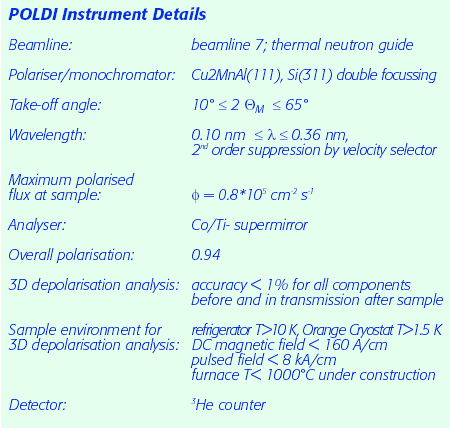PolDi
The polarised neutron diffractometer POLDI has been developed by the Physikalisch-Technische Bundesanstalt (PTB), Braunschweig. It was first installed and operated at the PTB research reactor. After its shut down POLDI was set up and is now operated by PTB at the thermal neutron guide 7 of the FRG-1.
The polarised neutron diffractometer POLDI is equipped with a set-up for full 3-dimensional depolarisation analysis (NDA) of the beam transmitted by the sample. It is a unique instrument in that it offers this capability in a large range of wavelengths (from 0.10 nm to 0.36 nm). Therefore it is especially adapted to studies of the ferromagnetic domain structures and ferromagnetic correlations in a range from 20 nm to several mm. This information can be obtained from the changes of the polarisation of the neutron beam during the passage through the sample. The quantity observed is the 3 x 3 depolarisation matrix D , which relates the initial polarisation Po to the final polarisation P = D Po. The depolarisation yields the mean domain size d and the magnetic texture gi in multi-domain samples, e. g. the structure of the magnetisation is observed on a mesoscopic length scale. The rotation of the polarisation provides the macroscopic induction B= moM of the sample under the same conditions as for the observation of the domain structure. The instrument provides the measurement of these quantities as function of external parameters applied to the sample: temperature, applied magnetic field, sample orientation, sample history.
Apart from the mode as neutron pola-rimeter NDA, POLDI can be operated as a conventional 2-axis diffractometer with or without simple polarisation analysis. Optionally it can be used for time-of-flight experiments in order to test detectors etc. as for the metrology of neutron dose meters.

The neutron beam is monochromatised and polarised parallel to the z-axis by the (111) Bragg reflection from a Heusler crystal (Cu2MnAl, Pol). After traversing the magnetically shielded sample box (SSB) the final polarisation of the beam is analysed by the supermirror analyser (Ana) and the neutrons are detected by the 3He detector(D). By means of the rotators (R1 and R2) each of the 3 components of the initial polarisation Po can be prepared and each of the 3 components of the final polarisation P can be projected onto the analyser, thus determining the depolarisation matrix D. From the rotation of Po along the passage through a sample the macroscopic induction in the sample will be obtained as well as the mesoscopic structure of the magnetisation (mean domain size and magnetic texture) from the depolarisation.
